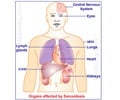A new study says that, long-term exposure to ozone-one of the most widespread pollutants in the world and a key component of smog-significantly increases the risk of dying from lung disease.
A new study says that, long-term exposure to ozone-one of the most widespread pollutants in the world and a key component of smog-significantly increases the risk of dying from lung disease.
The study found that the risk of dying from respiratory disease is more than 30 percent greater in metropolitan areas with the highest ozone concentrations than in those with the lowest ozone concentrations."Many studies have shown that a high-ozone day leads to an increase in risk of acute health effects the next day, for example, asthma attacks and heart attacks," said George D. Thurston, Sc.D. who directed the air pollution exposure assessment part of the study.
"What this study says is that to protect the public's health, we can't just reduce the peaks, we must also reduce long-term, cumulative exposure," Thurston added.
For the study, researchers analyzed data on some 450,000 people who were followed from 1982 to 2000 as part of an American Cancer Society study. Over that period 118,777 people in the study died.
The data, which included cause of death, were linked to air pollution levels in 96 cities using advanced statistical modeling to control for individual risk factors, such as age, smoking status, body mass, and diet, as well as for regional differences among the study populations.
By statistically controlling for the other major component of smog-fine particulate matter, particles smaller than 2.5 microns-the researchers were able to tease out the cardiovascular impact of the pollutants and still see ozone's effects on respiratory health.
Advertisement
The researchers estimate that the risk of dying from respiratory causes rises 4 percent for every 10 parts-per-billion increase in exposure to ozone.
Advertisement
This long-term cumulative exposure corresponded to roughly a 50 percent increased risk of dying from lung disease compared to no exposure to the pollutant.
The lowest ozone concentration was seen in San Francisco (33 ppb long-term average daily maximum), which had an associated 14 percent increase in risk.
The study has been published in the March 12 issue of the New England Journal of Medicine.
Source-ANI
ARU/L












